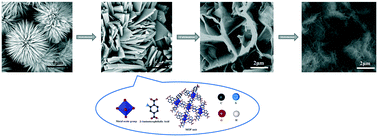Optimization of the overall water-splitting performance of N, S co-doped carbon-supported NiCoMnSx−10 at high current densities by the introduction of sulfur defects and oxygen vacancies†
Abstract
Designing an electrocatalyst with excellent performance for both the hydrogen evolution reaction and oxygen evolution reaction in overall water splitting is essential to promote the development of electrolyzed hydrogen production. Defect engineering is a promising method to improve the catalytic performance of target materials. In this study, we used a metal–organic framework as a precursor to establish oxygen-vacancy-rich metal oxide groups supported by a defect-rich carbon framework via calcination. Further, thermal ion exchange was performed to introduce sulfur ions to generate NiCoMnSx−10 with both oxygen vacancies and sulfur defects. Due to the synergistic effect between oxygen vacancies and sulfur defects as well as the good morphology, NiCoMnSx−10 exhibited good catalytic performance at high current densities. The NiCoMnSx−10 cell could achieve a current density of 10 mA cm−2 at a cell voltage of 1.506 V and a current density of 100 mA cm−2 at an overpotential of only 1.94 V, which exceeds that of most materials reported to date. Due to the supporting effect of N, S co-doped carbon, the NiCoMnSx−10 cell maintained stable performance during a 100 h operation at high current. This work provides an innovative method for the preparation of highly efficient electrocatalysts for overall water splitting.

- This article is part of the themed collection: Editor’s Collection: Imperfect nanocrystals for Perfect Catalysis


 Please wait while we load your content...
Please wait while we load your content...